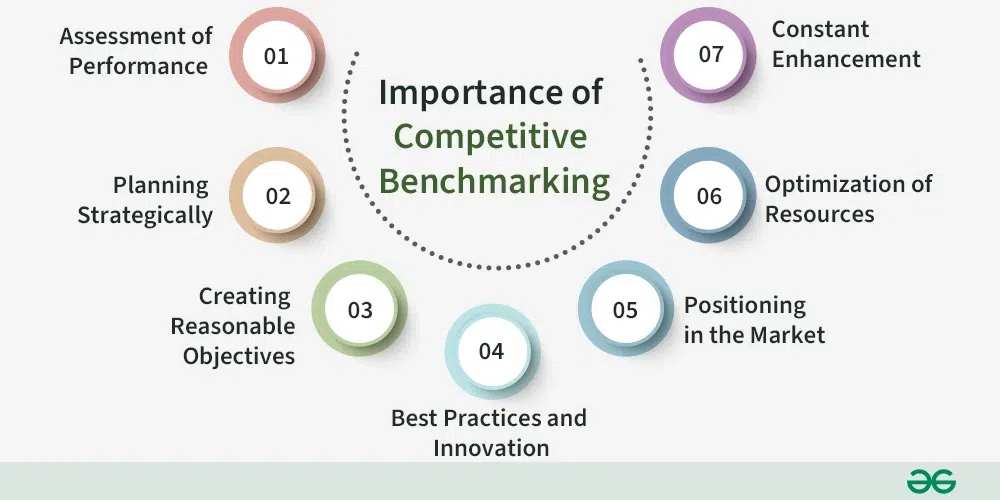Introduction: What Is Competitive Benchmarking?
Competitive benchmarking is the process of comparing your company’s performance, strategies, and outcomes with direct or indirect competitors to identify best practices and areas for improvement. It helps businesses assess where they stand in the market, uncover performance gaps, and develop strategic initiatives for growth.
By leveraging industry benchmarks and competitor analysis, companies can enhance customer satisfaction, streamline operations, and stay ahead of market trends. In an increasingly saturated and dynamic market, competitive benchmarking is no longer optional—it’s essential.
Why Is Competitive Benchmarking Important?
Understanding what is competitive benchmarking means recognizing its impact on key business functions:
- 🔍 Strategic Insight: It uncovers what your competitors are doing right (and wrong), giving you clarity for strategic planning.
- 📊 Performance Evaluation: You can measure your business performance using benchmarking metrics like market share, conversion rates, or customer retention.
- 💡 Innovation Opportunities: Discover gaps in the market and areas where you can outperform the competition.
- 🔄 Continuous Improvement: Helps refine processes using real-world data and performance metrics.
Types of Competitive Benchmarking
There are several types of competitive benchmarking, each serving a different purpose depending on your business objectives:
1. Strategic Benchmarking
Focuses on long-term strategies, business models, and overall positioning. For example, comparing the go-to-market strategy of a leading competitor with your own.
2. Performance Benchmarking
Uses quantitative metrics like sales volume, revenue per user, or social engagement to evaluate your market standing.
3. Process Benchmarking
Looks at operational workflows, such as customer service response times or product delivery methods.
4. SWOT-Based Benchmarking
Incorporates a SWOT analysis (Strengths, Weaknesses, Opportunities, Threats) to map out internal vs. external advantages.
The Competitive Benchmarking Process: Step-by-Step
Step 1: Identify Key Competitors
Use tools like Semrush, Ahrefs, or SimilarWeb to identify direct and indirect competitors in your industry.
Step 2: Choose Metrics to Measure
Select specific KPIs (Key Performance Indicators) that align with your business goals:
- Website traffic
- Social media engagement
- Product pricing
- Customer reviews
Step 3: Collect and Analyze Data
Leverage benchmarking tools and industry reports to gather data. Focus on both qualitative and quantitative insights.
Step 4: Compare and Contrast
Use a competitive analysis framework such as a competitor matrix or benchmarking dashboard to visualize data differences.
Step 5: Set Improvement Goals
Translate insights into action by setting SMART goals (Specific, Measurable, Achievable, Relevant, Time-bound).
Step 6: Implement Changes
Apply findings to adjust your marketing, sales, operations, or product development.
Step 7: Monitor Progress
Benchmarking is not a one-time task. Regular monitoring ensures you remain competitive.
Competitive Benchmarking vs. Competitor Analysis
While often used interchangeably, competitive benchmarking and competitor analysis are not the same:
| Aspect | Competitive Benchmarking | Competitor Analysis |
|---|---|---|
| Purpose | Evaluate relative performance | Understand competitor strategy |
| Focus | Metrics and outcomes | SWOT, tactics, and trends |
| Scope | Objective, data-driven | Often subjective and strategic |
Tools for Competitive Benchmarking
Here are some tools that can help you effectively benchmark your competitors:
- Semrush – SEO, traffic, and keyword benchmarking
- SimilarWeb – Web traffic and engagement analysis
- Sprout Social – Social media metrics comparison
- Google Trends – Popularity comparison of branded queries
- BuzzSumo – Content performance benchmarking
Real-World Example
Let’s say you run an eCommerce clothing brand. Your competitor, Brand X, has:
- 30% more web traffic
- Higher conversion rates
- Better product page designs
By benchmarking these areas, you identify:
- You lack mobile optimization
- Your CTAs are not as effective
- Your product filters are slow
Now, by redesigning your mobile site, refining CTAs, and improving UX, you can bridge the gap—and even surpass Brand X.
Benefits of Competitive Benchmarking
✅ Improves market positioning
✅ Supports strategic planning
✅ Drives customer satisfaction
✅ Enhances operational efficiency
✅ Informs product innovation
Challenges in Competitive Benchmarking
⚠️ Data Availability – Not all competitor data is public
⚠️ Misinterpretation – Comparing wrong KPIs leads to false assumptions
⚠️ Overfocus – Constantly chasing competitors can stifle originality
Tip: Use benchmarking as a guide, not a script.
How Often Should You Benchmark?
Ideally, quarterly or biannually. However, in fast-moving sectors like SaaS or digital marketing, monthly benchmarking might be necessary.
Final Thoughts
What is competitive benchmarking? In essence, it’s your roadmap to market leadership. By consistently evaluating your business against industry standards and key players, you gain the insights needed to grow smarter, faster, and more efficiently.
With the right benchmarking strategy, tools, and mindset, your business can not only keep up—but lead the way.
FAQs About Competitive Benchmarking
Q: Is competitive benchmarking only for large companies?
A: No, businesses of all sizes can benefit. Even startups can benchmark using publicly available tools and free analytics.
Q: Can I do competitive benchmarking for free?
A: Yes, using tools like Google Trends, Ubersuggest, and SimilarWeb’s free version can get you started.
Q: What industries benefit most?
A: E-commerce, SaaS, finance, healthcare, and digital services commonly use benchmarking to refine competitive strategies.
Disclosure
This article was created with the assistance of AI to ensure accuracy, structure, and comprehensive coverage, and was edited by our team to meet Google News and SEO best practices. It is original, plagiarism-free, and complies with all editorial standards.



